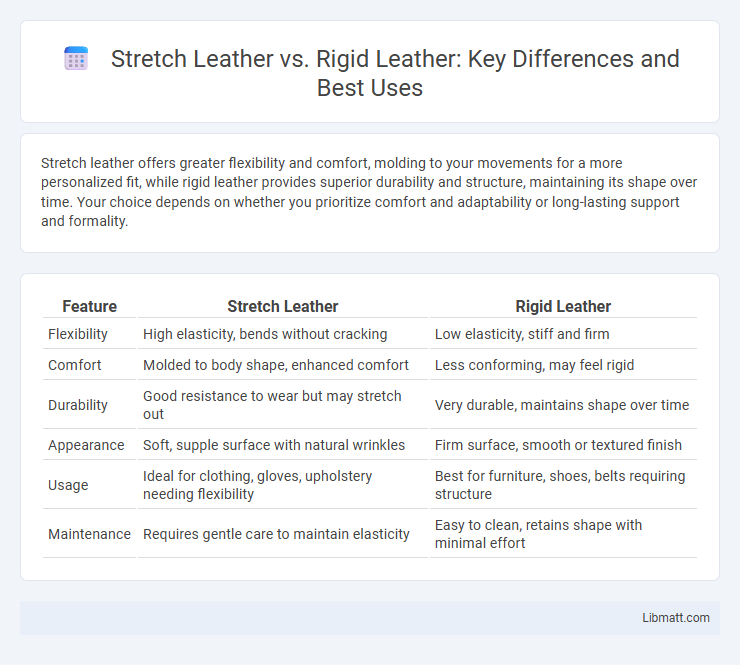Stretch leather offers greater flexibility and comfort, molding to your movements for a more personalized fit, while rigid leather provides superior durability and structure, maintaining its shape over time. Your choice depends on whether you prioritize comfort and adaptability or long-lasting support and formality.
Table of Comparison
| Feature | Stretch Leather | Rigid Leather |
|---|---|---|
| Flexibility | High elasticity, bends without cracking | Low elasticity, stiff and firm |
| Comfort | Molded to body shape, enhanced comfort | Less conforming, may feel rigid |
| Durability | Good resistance to wear but may stretch out | Very durable, maintains shape over time |
| Appearance | Soft, supple surface with natural wrinkles | Firm surface, smooth or textured finish |
| Usage | Ideal for clothing, gloves, upholstery needing flexibility | Best for furniture, shoes, belts requiring structure |
| Maintenance | Requires gentle care to maintain elasticity | Easy to clean, retains shape with minimal effort |
Introduction to Stretch Leather and Rigid Leather
Stretch leather offers enhanced flexibility and comfort due to its elastic fibers woven into the material, making it ideal for apparel and accessories requiring mobility. Rigid leather, known for its firm structure and durability, provides better support and shape retention, often favored in footwear and heavy-duty goods. Understanding the distinctions between stretch leather and rigid leather helps you choose the right type for your specific needs and style preferences.
Material Composition: What Sets Them Apart
Stretch leather incorporates elastic fibers or synthetic blends such as spandex or polyurethane within its natural hide matrix, enabling enhanced flexibility and resilience. Rigid leather is composed primarily of untreated or minimally treated full-grain or top-grain leather, known for its stiffness and durability but limited stretchability. The distinct material composition influences their usage in products requiring flexibility versus structural integrity, respectively.
Manufacturing Processes Compared
Stretch leather is created by infusing elastic fibers or applying specialized chemical treatments during manufacturing, enhancing flexibility and pliability without compromising durability. Rigid leather undergoes a traditional tanning process using natural oils and tannins, followed by minimal finishing treatments to preserve its firm, stiff structure. The manufacturing differences result in stretch leather being ideal for apparel requiring movement, while rigid leather suits applications demanding structural integrity.
Comfort and Fit: Stretch vs Rigid
Stretch leather offers enhanced comfort and a better fit by conforming to the wearer's foot shape, providing flexibility and reducing pressure points during movement. Rigid leather, while durable and supportive, often requires a break-in period as it maintains a stiff structure that might initially restrict comfort and adaptability. For footwear or apparel prioritizing immediate comfort and a custom fit, stretch leather is generally preferred over rigid leather.
Durability and Longevity
Stretch leather offers enhanced flexibility but may be less durable over time compared to rigid leather, which maintains its structure and resists wear more effectively. Rigid leather's dense fibers and minimal elasticity contribute to superior longevity, making it ideal for heavy-duty use and items requiring sustained shape retention. Your choice depends on prioritizing comfort and flexibility versus long-term durability and strength.
Style and Versatility Differences
Stretch leather offers greater flexibility and conforms to the body, making it ideal for form-fitting styles and dynamic wear, while rigid leather provides structured support and maintains its shape, suited for classic, tailored designs. The adaptability of stretch leather enhances comfort and allows for a broader range of movement, contributing to versatile casual and athleisure looks, whereas rigid leather excels in durability and sharp aesthetics favored in formal or vintage-inspired fashion. Differences in texture and resilience between stretch and rigid leather influence their application across various style preferences and functional uses.
Care and Maintenance Requirements
Stretch leather requires gentle care, including regular cleaning with a damp cloth and using conditioners formulated for flexible materials to maintain its suppleness and prevent cracking. Rigid leather demands more intensive maintenance, involving periodic application of leather oils or creams to keep it moisturized and prevent stiffness or brittleness. Your choice impacts the frequency and type of conditioning products needed to preserve the leather's durability and appearance.
Best Use Cases for Each Type
Stretch leather excels in applications requiring flexibility and comfort, making it ideal for form-fitting shoes, gloves, and upholstery where movement is frequent. Rigid leather suits products demanding durability and shape retention, such as belts, boots, and luxury handbags that benefit from a structured, long-lasting feel. Your choice depends on whether you prioritize adaptability or sturdiness in the final leather product.
Price and Value Analysis
Stretch leather typically commands a higher price due to its flexible properties and enhanced comfort, making it ideal for fashion-forward and ergonomic designs. Rigid leather, being more durable and traditional, offers long-term value through its resistance to wear and ability to develop a unique patina over time. Consumers prioritizing comfort and contemporary style often find stretch leather worth the premium, while those seeking longevity and classic appeal may prefer the cost-effectiveness of rigid leather.
Choosing the Right Leather for Your Needs
When choosing the right leather for your needs, consider that stretch leather offers superior flexibility and comfort, ideal for garments and accessories requiring mobility. Rigid leather provides durability and structure, making it perfect for items like belts, boots, and heavy-duty jackets. Your selection should balance practicality with the intended use to ensure longevity and satisfaction.
Stretch leather vs rigid leather Infographic

 libmatt.com
libmatt.com